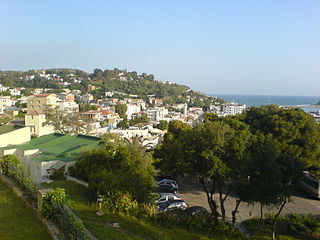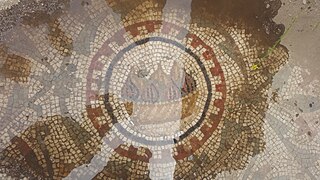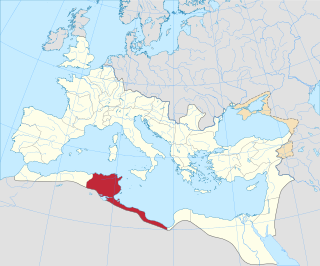Related Research Articles

Byzacena was a Late Roman province in the central part of Roman North Africa, which is now roughly Tunisia, split off from Africa Proconsularis.

Tabarka is a coastal town located in north-western Tunisia, close to the border with Algeria. Tabarka's history is a mosaic of Berber, Punic, Hellenistic, Roman, Arabic, Genoese and Turkish culture. The town is dominated by an offshore rock on which there remains a Genoese castle. Nationalist leader Habib Bourguiba, later president of post-independence Tunisia, was exiled on Tabarka by the French colonial authorities in 1952. Tourist attractions include coral fishing, the Coralis Festival of underwater photography, and its annual jazz festival.

The name Early African Church is given to the Christian communities inhabiting the region known politically as Roman Africa, and comprised geographically somewhat around the area of the Roman Diocese of Africa, namely: the Mediterranean littoral between Cyrenaica on the east and the river Ampsaga on the west; that part of it that faces the Atlantic Ocean being called Mauretania, in addition to Byzacena. Thus corresponding somewhat to contemporary Morocco, Algeria, Tunisia and Libya. The evangelization of Africa followed much the same lines as those traced by Roman civilization.

Maktar or Makthar, also known by other names during antiquity, is a town and archaeological site in Siliana Governorate, Tunisia.

The Catholic Church in Tunisia is part of the worldwide Catholic Church, under the spiritual leadership of the Pope in Rome.

Furnos was the name of two towns and bishoprics in the Roman province of Proconsular Africa. They are referred to as Furnos Maior and Furnos Minor, as now as separate Latin Catholic titular sees.

The Roman Catholic Archdiocese of Nampula is an archbishopric and the metropolitan see for one of the three ecclesiastical provinces in Mozambique in (south)eastern Africa, yet still depends on the missionary Roman Congregation for the Evangelization of Peoples.

Icosium was a Berber city that was part of Numidia which became an important Roman colony: in Icosium were settled many Roman colonists since Augustus times and there was an early medieval bishopric in what is now the casbah area of actual Algiers.

Zama, also known as Xama, in what is now Tunisia is best known for its connection with what is called the Battle of Zama, in which, on 19 October 202 BC, Scipio Africanus defeated Hannibal, ending the Second Punic War with victory for the Roman Republic, and breaking the power of Ancient Carthage.

Thignica was a town in the Roman province of Africa Proconsularis. It served as a Latin Catholic titular see.

Rakhlah, previously known as Zenopolis, is a village situated 31 kilometres (19 mi) west of Damascus, Syria. also known as "The town of Wine and Poetry".
Urusi was a civitas and ancient episcopal see of the Roman province of Africa Proconsularis in present-day Tunisia.

The Titular Bishopric of Vita (Vitensis) was a Roman–Berber civitas in Africa Proconsularis. It is a former Christian diocese and Latin Catholic titular see. The name 'Vita' means life.

Unizibira was an ancient town and bishopric in Roman North Africa which remains a Latin Catholic titular see.

Avensa was a Roman and Byzantine-era civitas (city), in Roman North Africa.

Abbir Germaniciana also known as Abir Cella is the name of a Roman and Byzantine-era city in the Roman province of Africa proconsularis. The city was also the seat of a bishopric, in the ecclesiastical province of Carthage, and is best known as the home town of the Pre Nicaean father, Cyprian, who was bishop of Abbir Germaniciana around 250AD.

Abbir Maius also known as Abbiritanus was a Roman and Byzantine-era civitas (city), later municipium, in the Roman province of Africa proconsularis.

Limisa is a town and archaeological site in Kairouan Governorate, Tunisia. It is located 50 kilometers west of kairouan. The town was a Roman Catholic diocese.

Henchir-Ed-Douamès is an archaeological site and locality in Tunisia, North Africa.

The Diocese of Aquensis in Byzacena is a home suppressed and titular see of the Roman Catholic Church.
References
- ↑ "Furnos Maius (Ain Fourna)". Trismegistos. Retrieved 13 January 2022.
- ↑ "Furnos Maior (Titular See)/Furnitanus Maior". Catholic-Hierarchy.org. Retrieved 13 January 2022.
- ↑ Hitchner, R. "Places: 314959 (Furnos Maius)". Pleiades. Retrieved 13 January 2022.
- ↑ "About: Furnos Maius, Ain-Fourna". Digital Atlas of the Roman Empire. Retrieved 13 January 2022.
- ↑ Poinssot, Louis (1926). "Siméon, évêque de Furnus Majus". Comptes rendus des séances de l'Académie des Inscriptions et Belles-Lettres (in French). 70 (4): 304–307.
- ↑ "Furni". Catholic Encyclopedia. Retrieved 13 January 2022.
- 1 2 "Furni". New Advent Catholic Encyclopedia. Retrieved 13 January 2022.
- ↑ Victor of Vita, History of the persecution by the Vandals , I, 3.
- ↑ "Bishop Aliaksandr Yasheuski, S.D.B." Catholic-Hierarchy.org. Retrieved 13 January 2022.
![]() This article incorporates text from a publication now in the public domain : Herbermann, Charles, ed. (1913). "Furni". Catholic Encyclopedia . New York: Robert Appleton Company.
This article incorporates text from a publication now in the public domain : Herbermann, Charles, ed. (1913). "Furni". Catholic Encyclopedia . New York: Robert Appleton Company.